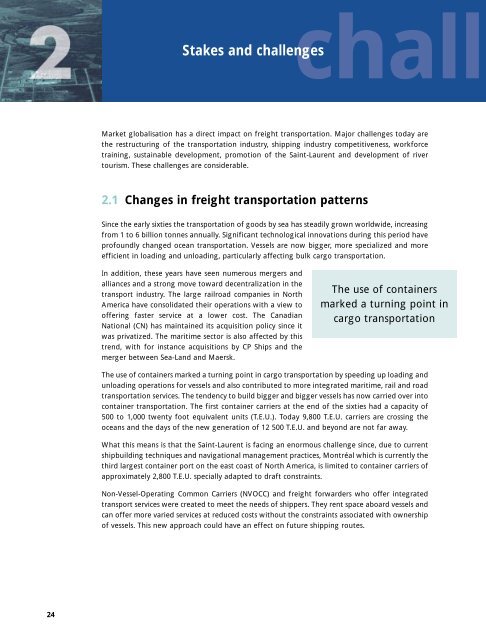Québec Marine Transportation Policy - Transport - Gouvernement ...
Québec Marine Transportation Policy - Transport - Gouvernement ...
Québec Marine Transportation Policy - Transport - Gouvernement ...
You also want an ePaper? Increase the reach of your titles
YUMPU automatically turns print PDFs into web optimized ePapers that Google loves.
24<br />
chall<br />
Stakes and challenges<br />
Market globalisation has a direct impact on freight transportation. Major challenges today are<br />
the restructuring of the transportation industry, shipping industry competitiveness, workforce<br />
training, sustainable development, promotion of the Saint-Laurent and development of river<br />
tourism. These challenges are considerable.<br />
2.1 Changes in freight transportation patterns<br />
Since the early sixties the transportation of goods by sea has steadily grown worldwide, increasing<br />
from 1 to 6 billion tonnes annually. Significant technological innovations during this period have<br />
profoundly changed ocean transportation. Vessels are now bigger, more specialized and more<br />
efficient in loading and unloading, particularly affecting bulk cargo transportation.<br />
In addition, these years have seen numerous mergers and<br />
alliances and a strong move toward decentralization in the<br />
transport industry. The large railroad companies in North<br />
America have consolidated their operations with a view to<br />
offering faster service at a lower cost. The Canadian<br />
National (CN) has maintained its acquisition policy since it<br />
was privatized. The maritime sector is also affected by this<br />
trend, with for instance acquisitions by CP Ships and the<br />
merger between Sea-Land and Maersk.<br />
The use of containers<br />
marked a turning point in<br />
cargo transportation<br />
The use of containers marked a turning point in cargo transportation by speeding up loading and<br />
unloading operations for vessels and also contributed to more integrated maritime, rail and road<br />
transportation services. The tendency to build bigger and bigger vessels has now carried over into<br />
container transportation. The first container carriers at the end of the sixties had a capacity of<br />
500 to 1,000 twenty foot equivalent units (T.E.U.). Today 9,800 T.E.U. carriers are crossing the<br />
oceans and the days of the new generation of 12 500 T.E.U. and beyond are not far away.<br />
What this means is that the Saint-Laurent is facing an enormous challenge since, due to current<br />
shipbuilding techniques and navigational management practices, Montréal which is currently the<br />
third largest container port on the east coast of North America, is limited to container carriers of<br />
approximately 2,800 T.E.U. specially adapted to draft constraints.<br />
Non-Vessel-Operating Common Carriers (NVOCC) and freight forwarders who offer integrated<br />
transport services were created to meet the needs of shippers. They rent space aboard vessels and<br />
can offer more varied services at reduced costs without the constraints associated with ownership<br />
of vessels. This new approach could have an effect on future shipping routes.


